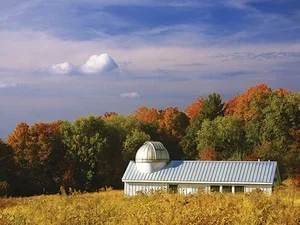Bennington to Analyze Impact of Campus Woodlands on Carbon Budget
In an effort to better understand and more accurately measure its institutional carbon budget, Bennington College is conducting a carbon sequestration analysis of the forests and woodlands on its 400-acre campus in southwestern Vermont.

The forests and woodlands of the campus constitute a substantial carbon reservoir. Based on average biomass density for temperate deciduous forests, 200 acres of forested land might support approximately 8,000 metric tons of carbon sequestered in biomass. The additional carbon being sequestered by 200 acres of young to middle-aged forests in the Northeast would be on the order of several hundred metric tons per year. Conservatively, a sink (increase in reservoir volume) of this magnitude could, in effect, offset the carbon emissions from burning something on the order of 50,000 gallons of gasoline.
Typical institutional carbon budgets do not take into account the role of natural and managed vegetation and associated soils in the carbon cycle. In this regard, Bennington hopes that its effort will help to establish methods and standards that can be more broadly applied by other institutions seeking a more complete understanding of their carbon budgets.
Additionally, with more detailed data on current vegetation and carbon cycling, it will be possible to assess the effects on carbon budgets of active forest management strategies (harvesting, planting, thinning, etc.) and of conversion of non-forested lands to forest.
Data analysis will begin this coming summer and continue through spring 2012.